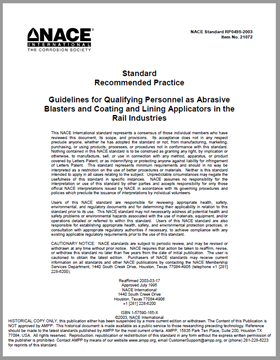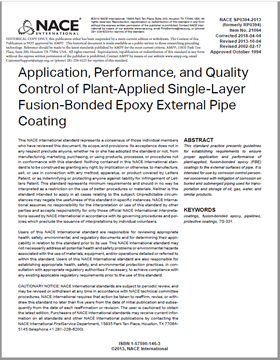This standard test method was prepared by NACE Task Group T-1 G-17 to serve as a tool in the process of evaluating elastomeric materials for use in the oilfield and other energy-related areas where sour gaseous environments are encountered. It is an accelerated aging procedure similar to ASTM(1) D471 (see Section 2), with additional information on sour environment testing under pressures greater than atmospheric pressure. By issuing specified test conditions, data from separate laboratories that utilize this method may be compared.
The committee knows of no technical organization that has issued a comparable standard test method. No attempt is made or implied to establish any pass/fail criteria for materials tested by this method. The change in properties of an elastomeric material is indicative of its resistance to the specific environment. The test can be regarded only as a measure of the resistance under the conditions of this particular test and not necessarily as having any direct relation to service value. The significance of the results can be determined only by each laboratory for its particular application.
The precision of this test method and reproducibility within and among laboratories has not been established. Specimens being tested using this method may be different in performance or alike within test error. The user of this method is encouraged to establish statistical significance of the data resulting from this method.
T -1 G-17 on Elastomers and Other Non metallics in Sour Service is a task group of Unit Committee T-1G on Protective Coatings and Nonmetallic Materials for Oilfield Use, which is a component of Group Committee T-1 on Corrosion Control in Petroleum
Production. These committees are composed of industry representatives including consumers, producers, and interested individuals. This standard was originally publishsed in 1987 and updated in 1992.
1.1 This test method measures the ability of elastomeric materials to withstand static exposure to elevated pressure and vapor phase sour gas environments, e.g., gaseous hydrocarbons with hydrogen sulfide, and is not designed to be an immersion or a functional test. It is designed for testing 0-rings or specimens of elastomeric vulcanites cut from standard sheets (see Paragraph 2.1.9 – ASTM D3182). The method is not applicable to the testing of cellular rubber or porous compositions.
1.2 This test method recommends procedures for the preparation of test specimens and equipment to be used, the test procedures to be followed, and procedures for reporting results. The test method also discusses test conditions, test media, and reagents. In summary, the test method specifies conditions of temperature, exposure time, and pressure for the exposure of test specimens to the influence of a gas. This gaseous environment contains hydrogen sulfide, carbon dioxide, methane, water vapor, and liquid hydrocarbon vapor. The results are determined by monitoring changes in physical and mechanical properties (i.e., mass, volume, compression set, hardness, tensile strength, ultimate elongation, and modulus), as well as change in appearance after exposure to the selected test medium.
1.3 In view of the wide range of service conditions, this test is intended to be a means of only initial material evaluation and is not intended to provide any direct correlation with service performance. This method is useful in conducting research and development of elastomeric vulcanites.
1.4 Safety Precautions: Hydrogen sulfide is an extremely toxic gas that must be handled with care. See Appendix A for safety considerations and information on toxicity of this gas.
Historical Document 1992




